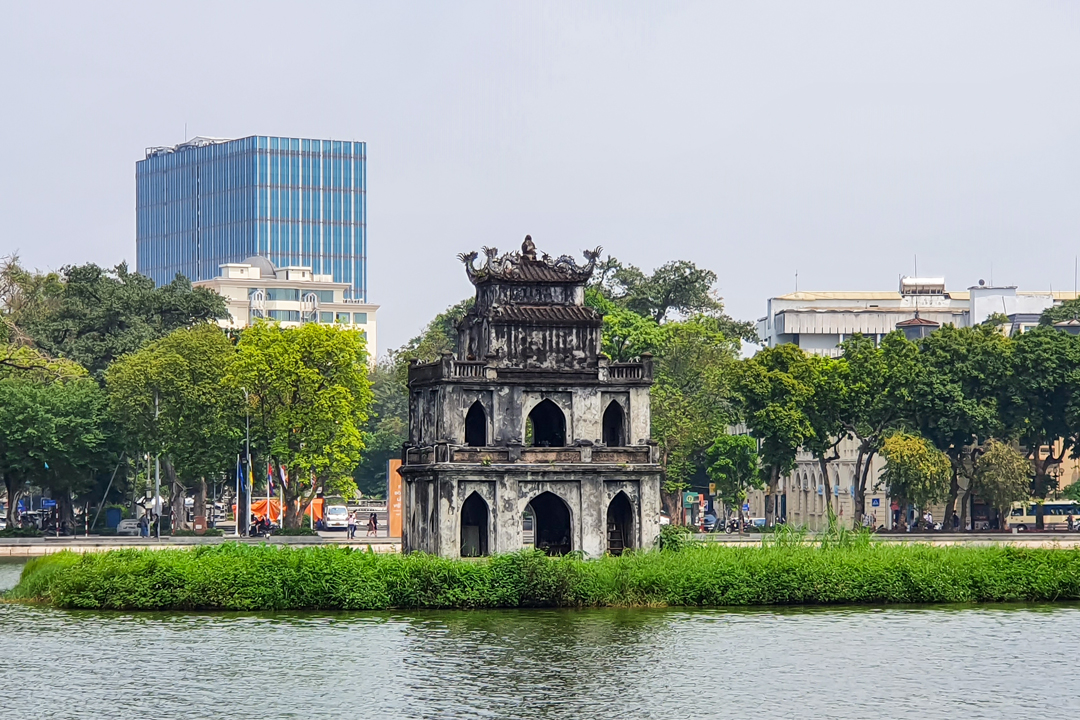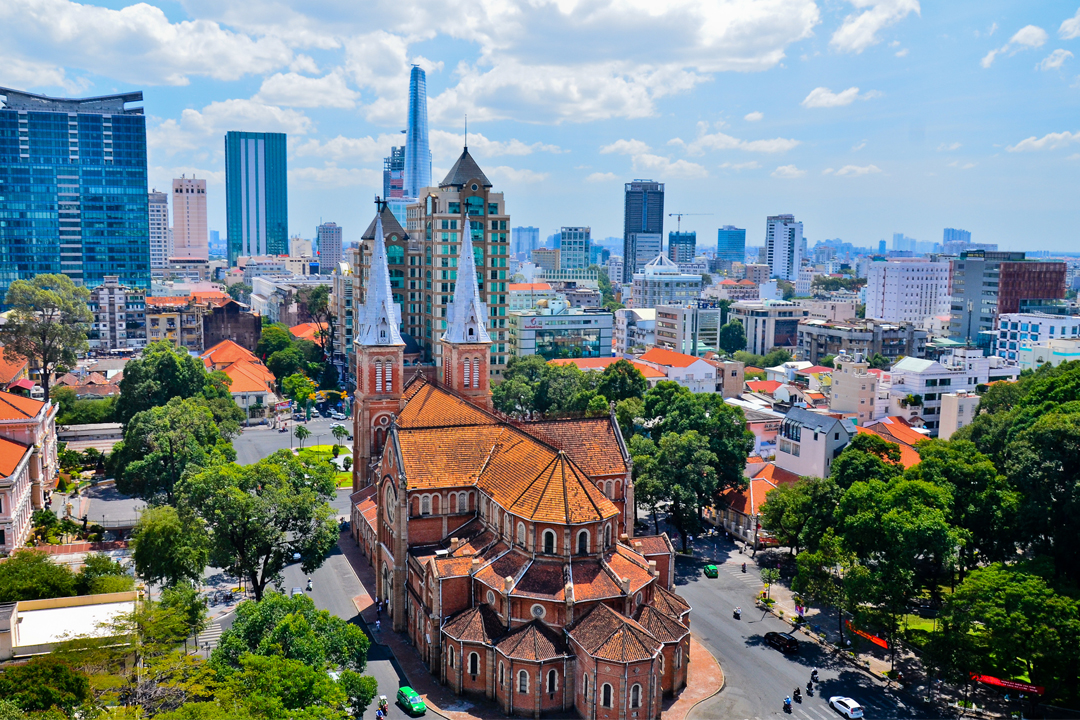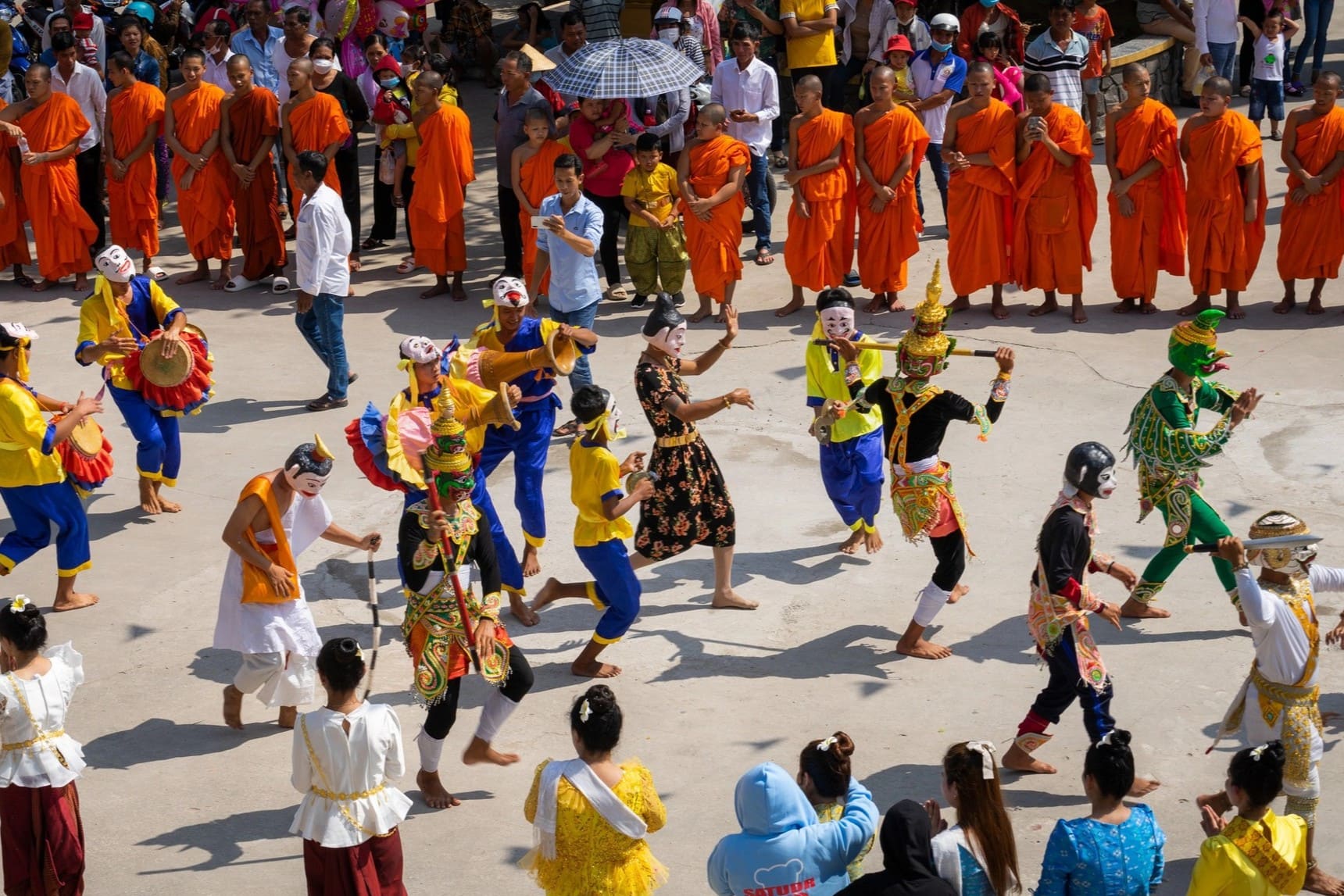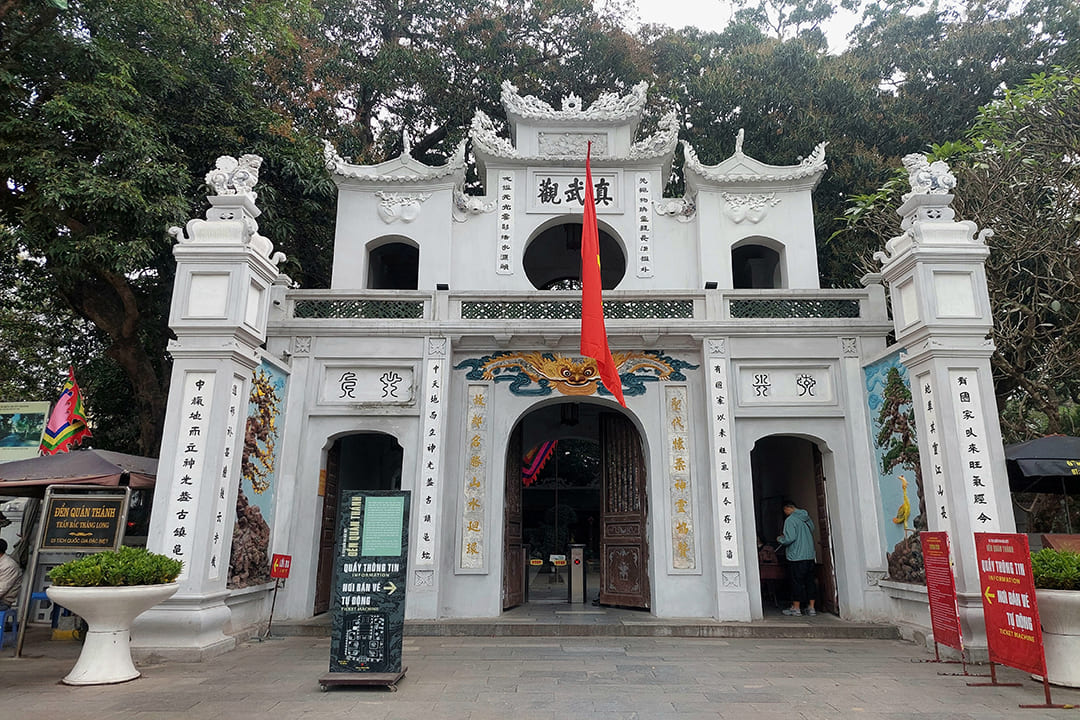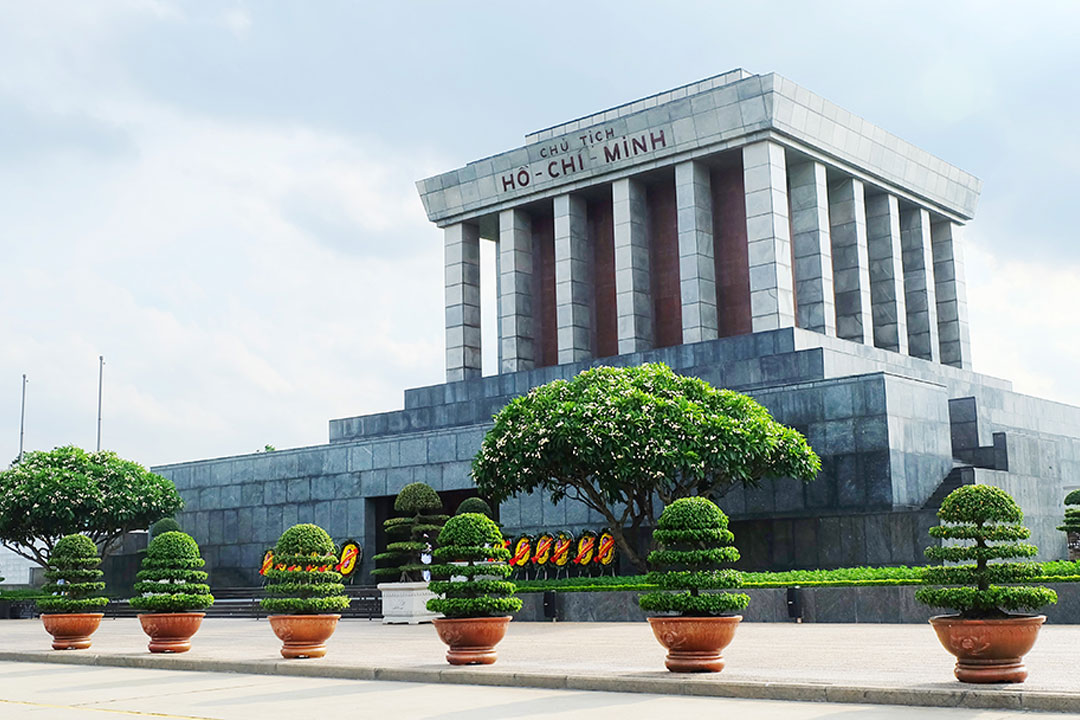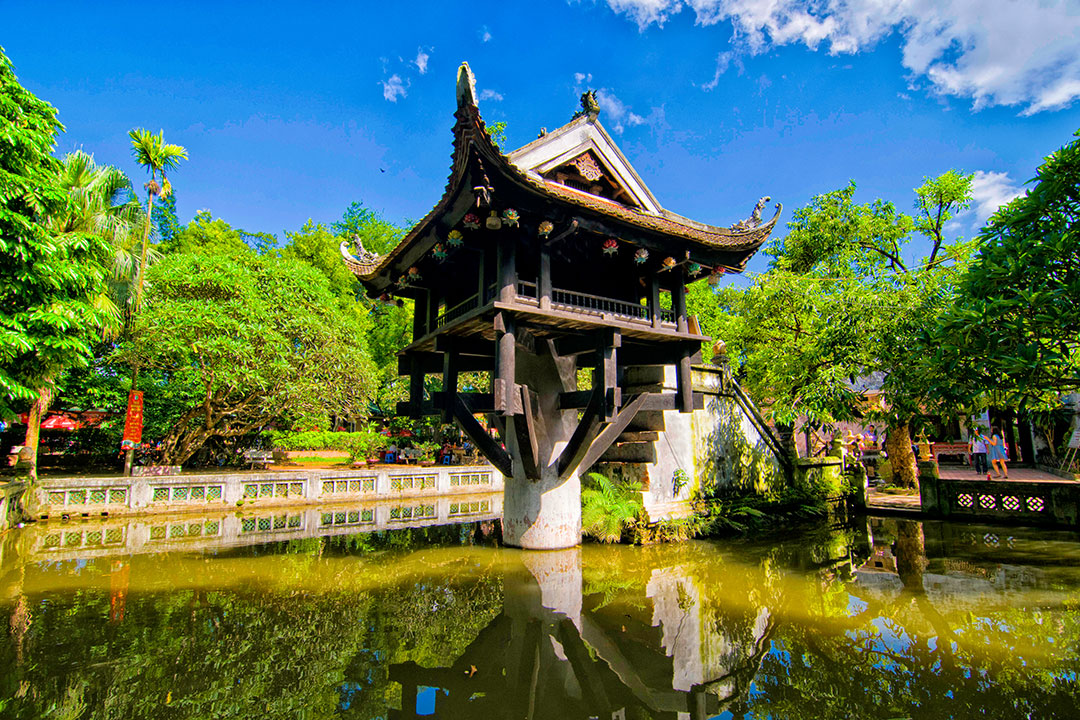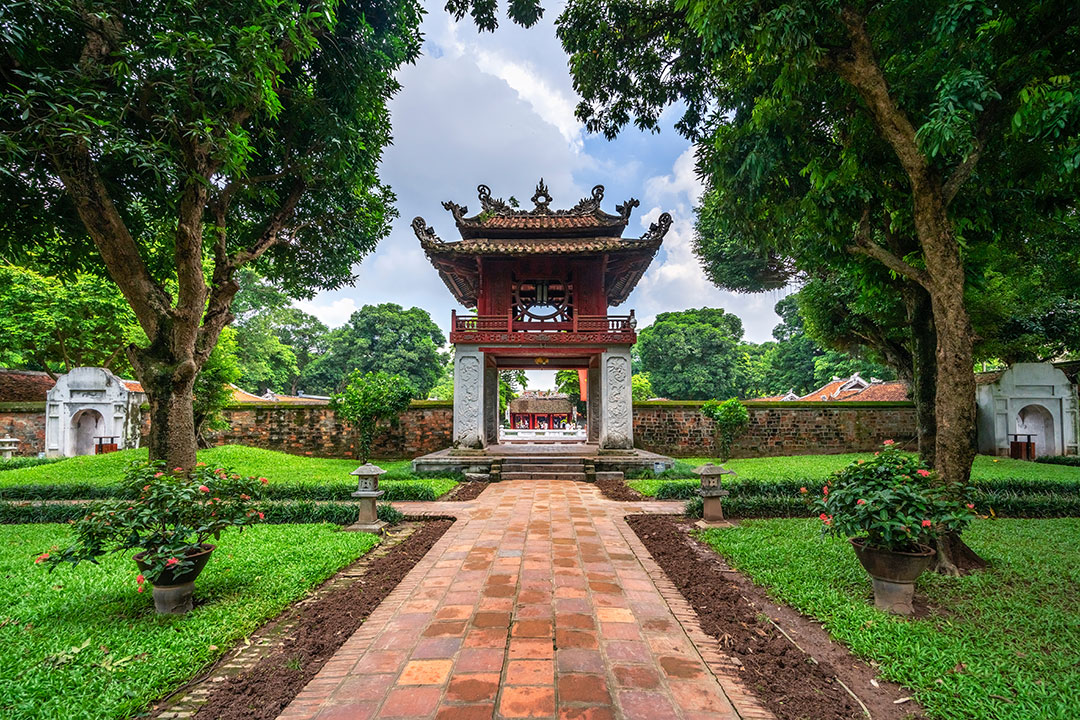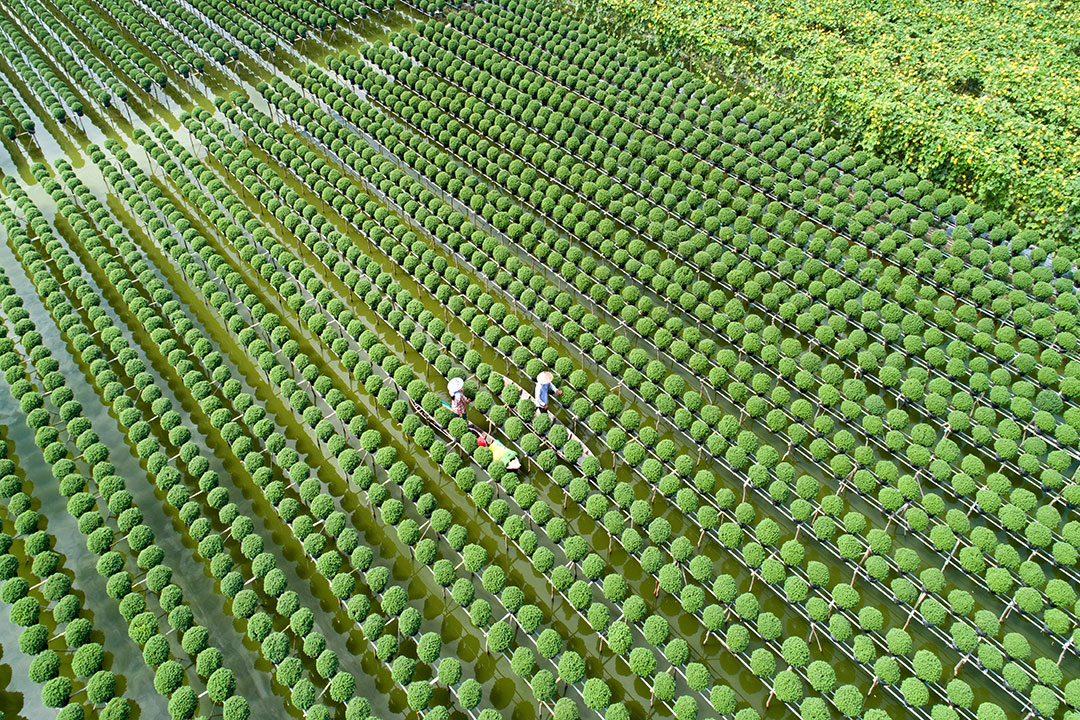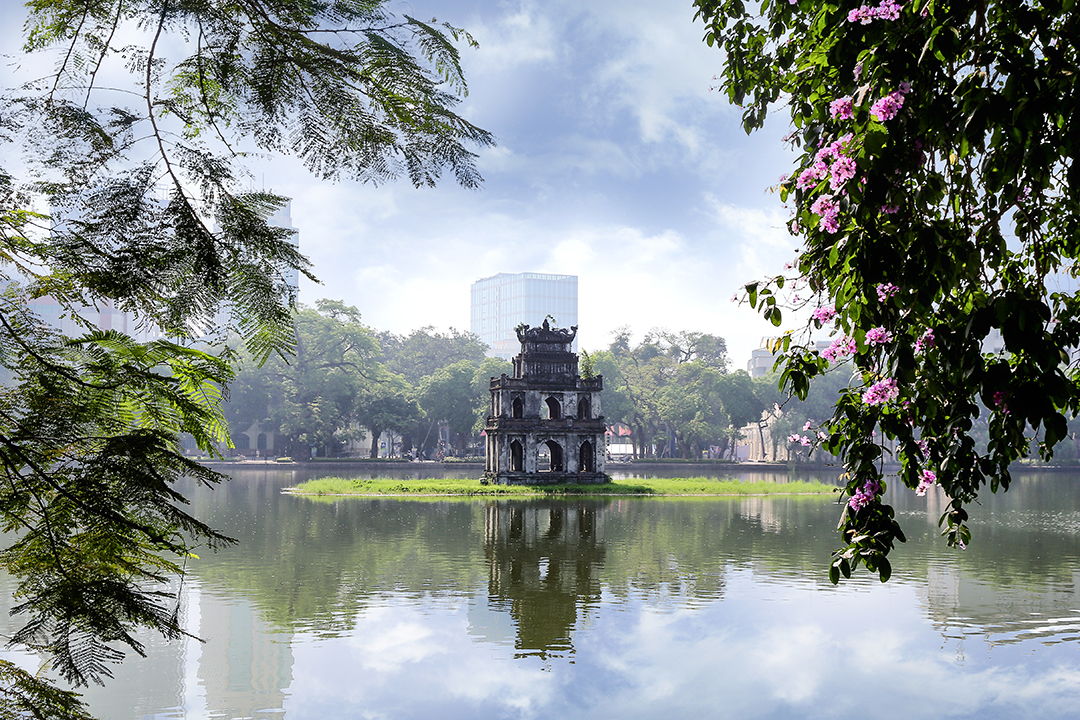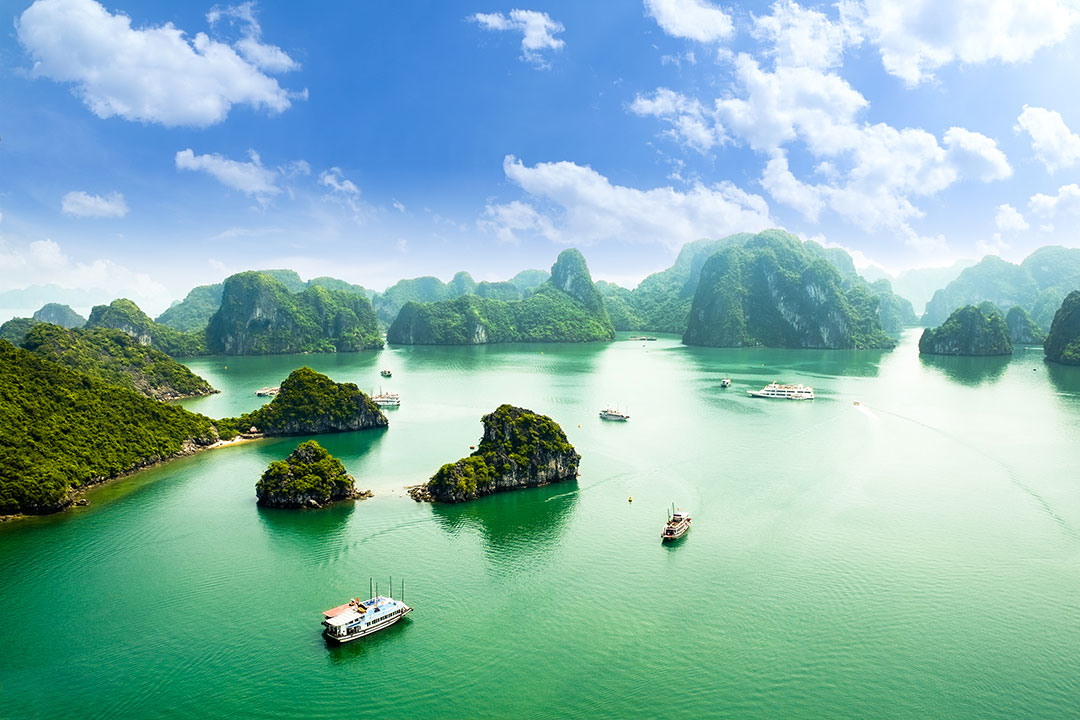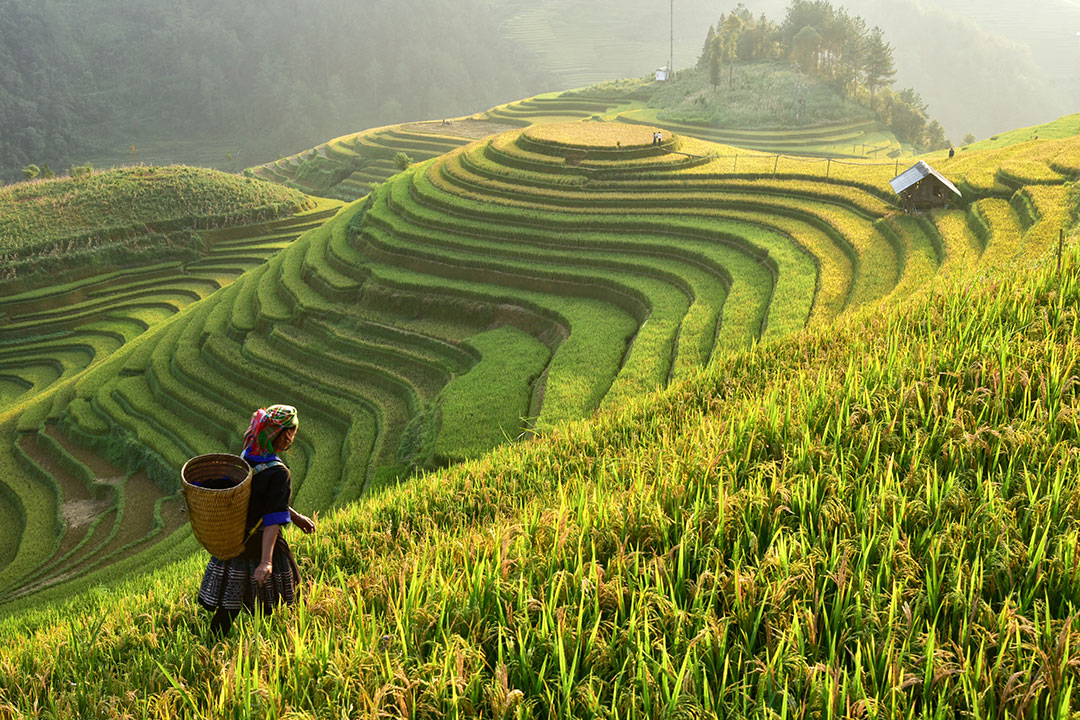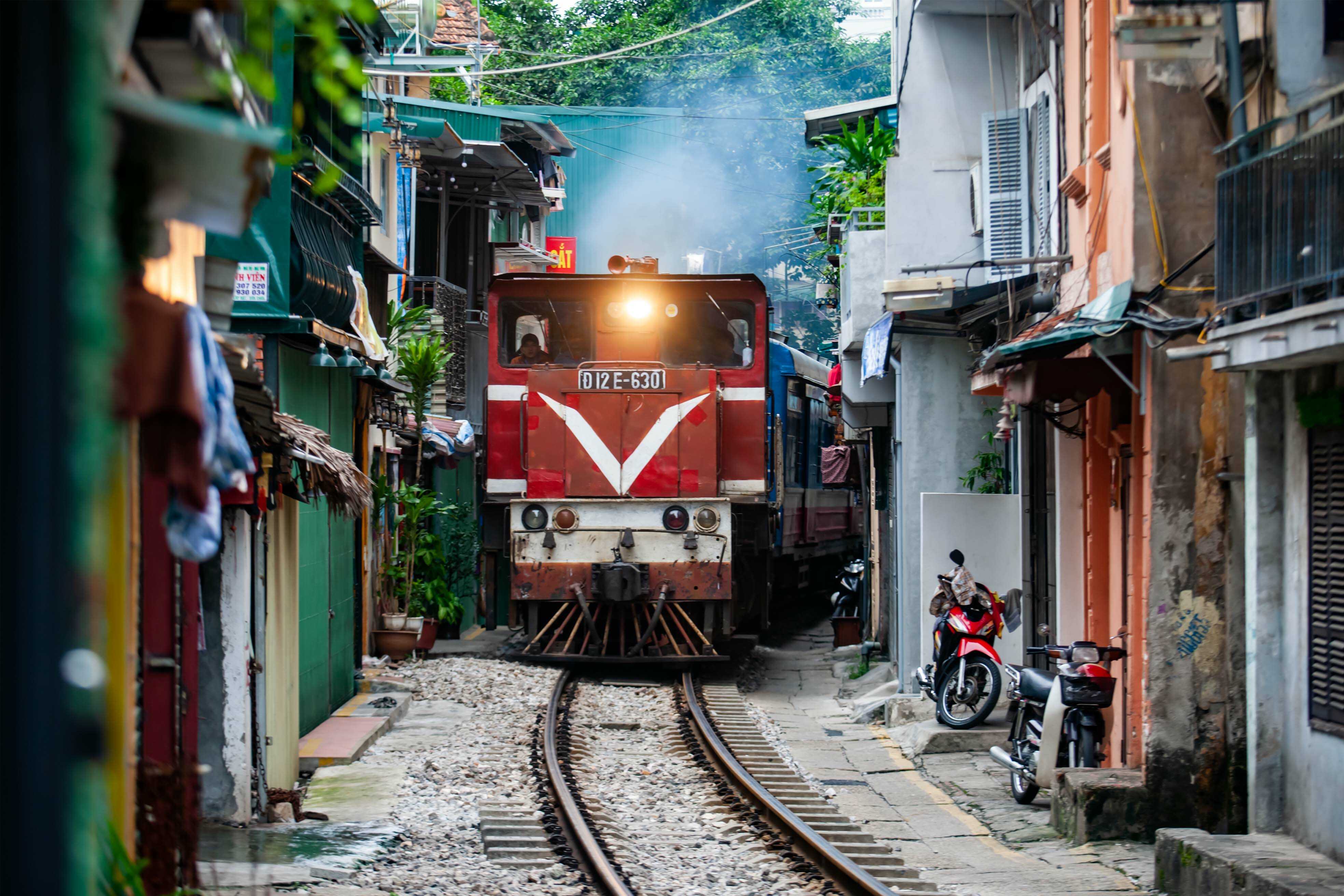Quan Thanh Temple: Essential Information, Architecture & Unique Experiences
Quan Thanh Temple, a tapestry interwoven with history and spirituality, beckons travelers seeking more than just picturesque landscapes in Hanoi. This revered temple is not just an architectural marvel but a testament to Vietnam's rich cultural narrative. For those curious about the depths of Vietnamese traditions or seekers of serene spiritual havens amid bustling city life, Quan Thanh Temple offers an enriching experience. Tourists are often drawn to its intricate carvings and storied past, which dates back to the early 11th century during the reign of Emperor Ly Thai To. GTrip invites you to delve deep into what makes Quan Thanh an essential part of Hanoi’s cultural identity in this article.
Essential information of Quan Thanh Temple
Quan Thanh Temple stands as one of Hanoi's ancient spiritual landmarks, drawing tourists with its sacred atmosphere and historical significance. Before planning your visit, understanding its location, operating hours, and entry requirements will help ensure a respectful and fulfilling experience at this venerable site.
Where is Quan Thanh Temple located?
Address: 190 Quan Thanh Street, Ba Dinh Ward (formerly Quan Thanh Ward, Ba Dinh District), Hanoi
Quan Thanh Temple (Den Quan Thanh), also known as Tran Vu Temple, enjoys a picturesque setting at the intersection of Hanoi's urban and natural landscapes. It sits at the corner where Quan Thanh Street meets Thanh Nien Street, creating an easily identifiable landmark. The temple faces the expansive West Lake (Ho Tay) while Truc Bach Lake lies nearby, offering a tranquil backdrop to this sacred site.
The strategic position between two lakes gives Quan Thanh Temple a uniquely serene atmosphere despite its urban location. You can easily combine their temple visit with exploration of the surrounding lakes and parkland. Many travelers appreciate the temple's accessibility within walking distance of other notable Hanoi attractions in the Ba Dinh area.
Opening hours and entry fee of Quan Thanh Temple
Quan Thanh Temple welcomes tourists daily from 8:00 AM to 5:00 PM throughout most of the year. During special occasions in the Vietnamese lunar calendar, the temple extends its hours to accommodate worshippers. On the 1st and 15th of every lunar month, the temple opens earlier at 6:00 AM and closes later at 8:00 PM, allowing for traditional worship practices. During Vietnamese New Year's Eve (Tet), the temple remains open continuously all day for celebration.
The entry fee structure remains affordable and accessible for most travelers. The ticket price is 10,000 VND/adult and free for children. Important notes for visitors:
- Wear respectful attire with knees and shoulders covered as a sign of reverence for this sacred site.
- Maintain a quiet demeanor throughout your visit, avoiding loud conversations that could disturb worshippers.
- Remove shoes when entering certain prayer areas within the temple complex.
- Photography is permitted in most areas, but avoid using flash around the main altar.
- Keep the temple premises clean by properly disposing of any waste.
- Consider visiting early morning for a more peaceful experience with fewer crowds.
- Show respect when locals are performing religious ceremonies by maintaining a distance.
Following these guidelines ensures both a fulfilling visitor experience and preserves the sanctity of this important cultural landmark for future generations.

Quan Thanh Temple, also known as Tran Vu Temple, represents one of the Four Sacred Temples protecting the cardinal directions of ancient Hanoi
Best time to visit Quan Thanh Temple
Quan Thanh Temple welcomes visitors throughout the year, but timing your visit strategically can significantly enhance your experience. The temple operates daily from 8:00 AM to 5:00 PM for regular tourists seeking spiritual encounters or cultural exploration. Special extended hours from 6:00 AM to 8:00 PM accommodate devotees on the 1st and 15th days of each lunar month, when religious activities peak.
For an authentic cultural immersion, plan your visit during significant Vietnamese celebrations. The Lunar New Year (Tet Holiday) transforms the temple into a vibrant hub of activity with colorful decorations, incense offerings, and locals praying for prosperity. The temple's dedicated festival on the 3rd day of the third lunar month showcases traditional rituals, folk performances, and ceremonial processions that rarely appear during ordinary days.
Weather considerations also play a crucial role in optimizing your visit:
- Autumn (September - November): The ideal season with temperatures between 20-24°C, minimal rainfall, and comfortable humidity for exploring the temple grounds
- Spring (February - April): Pleasant weather with occasional light rain showers and moderate temperatures around 18-23°C
For the most peaceful experience, arrive early in the morning (8:00 - 10:00 AM) when the temple first opens or later in the afternoon (3:00 - 5:00 PM) before closing. These quieter periods allow for contemplative moments among the ancient architecture without the distraction of large tour groups that typically arrive midday.
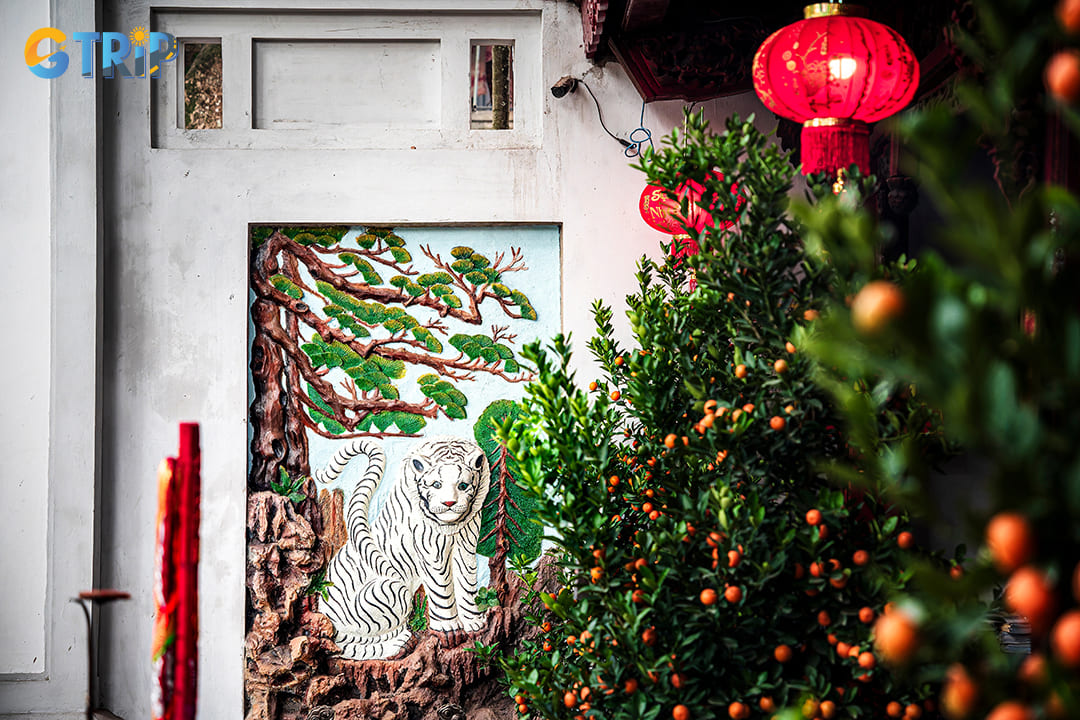
Quan Thanh Temple welcomes visitors throughout the year
How to get to Quan Thanh Temple?
Quan Thanh Temple enjoys a prime location on Thanh Nien Street, making it easily accessible for tourists exploring Hanoi. The temple sits between West Lake and Truc Bach Lake, creating a picturesque setting that's well-connected to the city's transportation network. Several transportation options are available depending on your preferences, budget, and location within Hanoi.
By car
Getting to Quan Thanh Temple by car is straightforward and convenient for those who prefer private transportation:
- The temple is marked on most GPS systems and maps as "Den Quan Thanh" or "Quan Thanh Temple"
- There is ample signage around the Old Quarter and West Lake area directing tourists to the temple
- The address (Quan Thanh Street, formerly Ba Dinh District) is well-known among local drivers
- If using ride-hailing apps like Grab or local taxis, simply enter "Quan Thanh Temple" as your destination
Regarding parking:
- A dedicated parking area is available approximately 50 meters from the temple entrance
- Parking fees range from 10,000 - 20,000 VND ($0.40 - 0.80) for motorcycles and 20,000 - 30,000 VND ($0.80 - 1.20) for cars
- Attendants are on duty to help guide vehicles and ensure security
- During peak tourist seasons or festival days, arrive early as parking spaces fill quickly
By motorbike or bicycle
Motorbikes and bicycles offer flexible and authentic ways to reach the temple while enjoying Hanoi's vibrant streets:
For motorbike travelers:
- Follow Thanh Nien Street, which runs between West Lake and Truc Bach Lake
- The temple sits on the eastern side of the road, easily identifiable by its traditional Vietnamese architecture
- Dedicated motorbike parking is available at the temple for 5,000 - 10,000 VND ($0.20 - 0.40)
- Rental motorbikes are widely available throughout Hanoi for around 100,000 - 150,000 VND ($4 - 6) per day
For cyclists:
- Hanoi's relatively flat terrain makes cycling a pleasant option for reaching the temple
- Bicycle rentals are available from many hotels and dedicated rental shops for approximately 50,000 - 100,000 VND ($2 - 4) per day
- The scenic route along the lakes provides beautiful views en route to the temple
- Bicycle parking is available near the temple entrance, typically free of charge or for a minimal fee
By bus
Hanoi's public bus system provides an economical and efficient way to reach Quan Thanh Temple:
| Bus Number | Route | Frequency | Fare |
|---|---|---|---|
| 50 | Giap Bat - Long Bien | Every 15-20 minutes | 7,000 VND |
| 45 | Gia Lam - Kim Ma | Every 20-25 minutes | 7,000 VND |
| 14 | Gia Lam - Cau Giay | Every 15-20 minutes | 7,000 VND |
| 22 | Gia Lam - Soc Son | Every 30 minutes | 7,000 VND |
| 22A | Nhat Tan - Ba Vi | Every 30 minutes | 7,000 VND |
The most efficient route follows Lang - Lang Ha - Hoang Cau - Ton Duc Thang streets. Buses generally operate from 5:00 AM to 9:00 PM daily. When traveling by bus:
- Request the stop nearest to "Den Quan Thanh" or "Quan Thanh Temple" from the driver or conductor
- The temple is a short 2-5 minute walk from most nearby bus stops
- Keep small denominations of Vietnamese Dong handy for bus fare
- During rush hours (7:30 - 8:30 AM and 5:00 - 6:30 PM), buses may be crowded, so plan accordingly
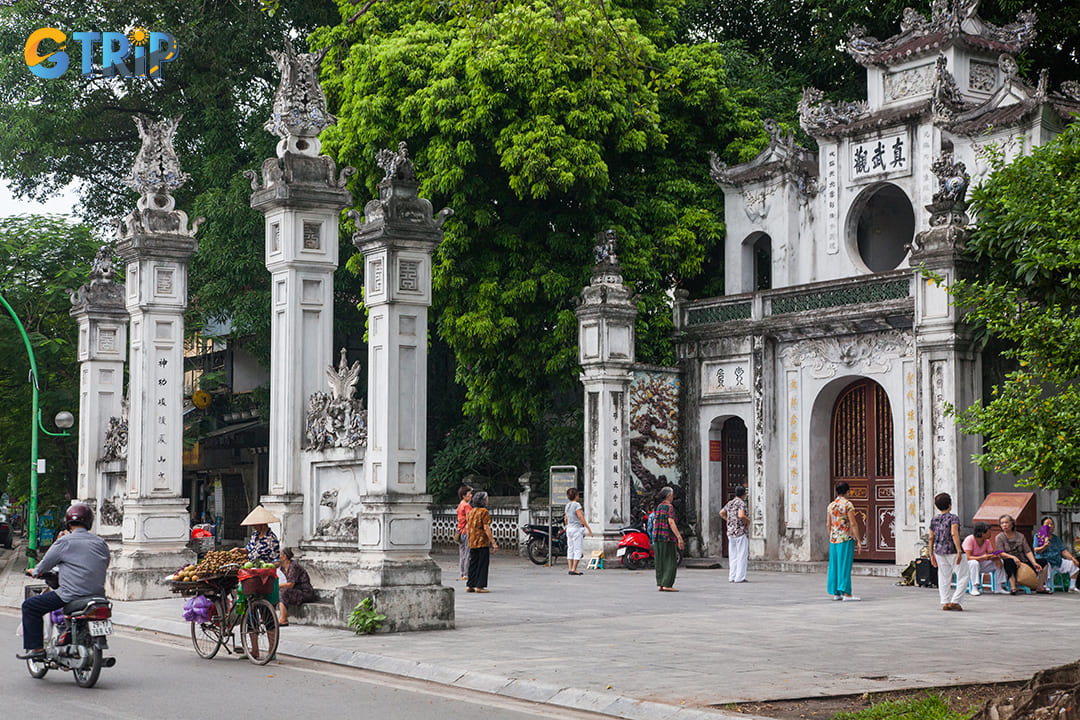
Quan Thanh Temple enjoys a prime location on Thanh Nien Street, making it easily accessible for tourists exploring Hanoi
The historical significance of Quan Thanh Temple
Quan Thanh Temple stands as one of Hanoi's Four Sacred Temples, strategically positioned to guard the city's northern direction according to ancient geomantic principles. Built in 1010 AD during Emperor Ly Thai To's reign, when he established Thang Long (modern-day Hanoi) as the capital, the temple has witnessed over a millennium of Vietnamese history. The temple emerged as part of the emperor's defensive spiritual system, designed to protect the newly established imperial city from malevolent forces.
Dedicated to Huyen Thien Tran Vu, a powerful deity in Vietnamese Taoism associated with the North and water elements, the temple holds profound spiritual importance. This dark-complexioned god, often depicted wielding a sword and commanding a turtle and snake, protects against evil spirits and natural calamities. Through centuries of war and peace, locals have sought his protection, believing he safeguards not just the temple grounds but the entire capital city.
The temple has endured numerous historical challenges, surviving invasions, natural disasters, and political upheavals while undergoing significant restorations:
- 17th century restoration: Conducted during the Later Le Dynasty, enhancing the temple's structural integrity while preserving its original architectural elements
- 19th century renovation: Major work undertaken during the Nguyen Dynasty, adding imperial artistic influences and expanding the complex
- 20th century conservation: Modern preservation efforts focused on maintaining historical authenticity while addressing structural degradation
- UNESCO recognition: While not individually listed, the temple contributes to Hanoi's cultural landscape, recognized for its historical value
Quan Thanh Temple represents more than a religious structure. It embodies the spiritual resilience of Vietnamese culture through changing times. The temple's continued significance after a thousand years demonstrates its central place in Hanoi's cultural identity. Its endurance through dynasty changes, foreign occupations, and modernization reflects the Vietnamese commitment to preserving spiritual heritage despite historical challenges.
As one of the oldest surviving religious structures in the capital, Quan Thanh Temple serves as a living museum of Vietnamese religious practices, architectural techniques, and artistic traditions. The temple's historical timeline parallels Hanoi's evolution from imperial capital to modern metropolis, making it an irreplaceable cultural landmark that continues to connect contemporary Vietnamese society with its ancient spiritual roots.
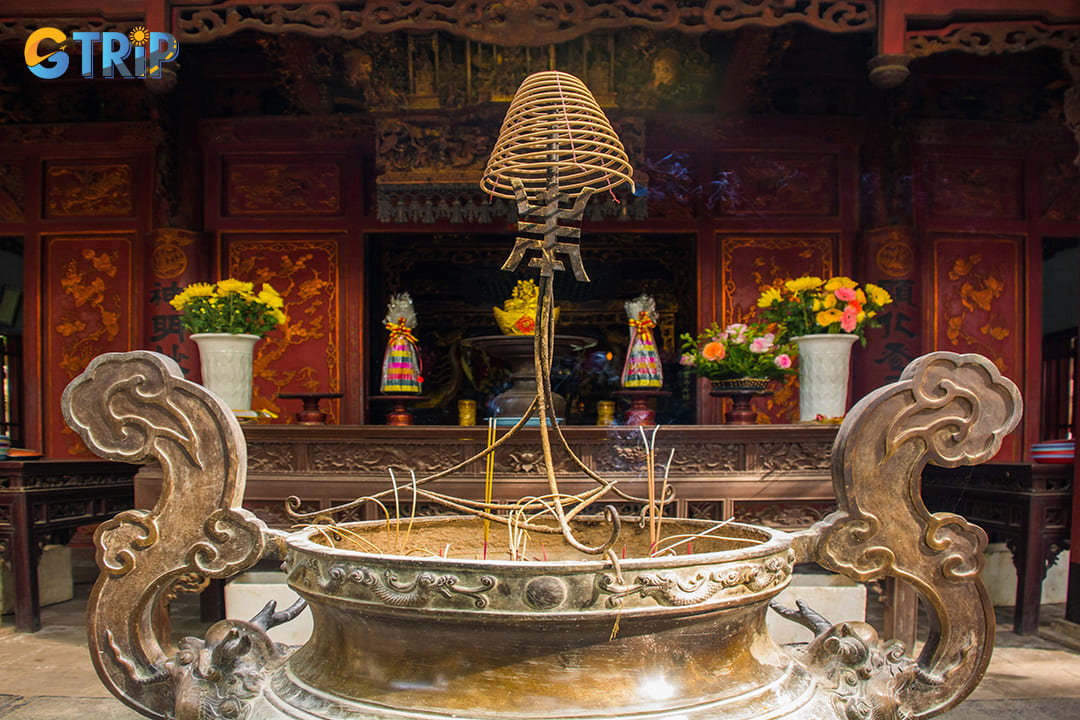
Quan Thanh Temple stands as one of Hanoi's Four Sacred Temples, strategically positioned to guard the city's northern direction according to ancient geomantic principles
Who is the key Deity of Quan Thanh Temple?
At the spiritual heart of Quan Thanh Temple stands Huyen Thien Tran Vu, one of the most revered deities in Vietnamese Taoism. Known as the Dark Heavenly Guardian, this powerful deity serves as the primary protector of the north direction in Hanoi. Tourists to the temple immediately notice his commanding presence through the massive bronze statue that dominates the main sanctuary.
The Sacred Guardian of the North
Huyen Thien Tran Vu holds a special place in Vietnamese spiritual tradition as the Deity of the North. His name reflects his cosmic significance, "Huyen" meaning dark or mysterious, "Thien" referring to heaven, and "Tran Vu" indicating his role as guardian. According to ancient beliefs, he watches over the northern quadrant of the heavens and protects Hanoi from malevolent forces approaching from this direction.
The deity's legendary powers stem from his mastery of multiple spiritual disciplines and martial arts. Vietnamese folklore describes him as a celestial figure who achieved enlightenment through rigorous spiritual practice. His divine status grew from his ability to vanquish demons and protect the innocent from harm.
Symbolism and significance
Huyen Thien Tran Vu embodies several powerful qualities that resonate with worshippers:
- Martial strength: Depicted with a sword or turtle and snake underfoot
- Spiritual transcendence: Represented by his calm, meditative expression
- Protective energy: Shown through his commanding posture
- Cosmic balance: Symbolized by his role among the four directional deities
- Divine authority: Illustrated by his imperial garments and posture
The impressive 4-ton bronze statue created in 1677 remains one of Vietnam's most remarkable religious sculptures. Standing over 3 meters tall, this masterpiece portrays the deity with a stern, focused expression. The intricate details of his robes and armor showcase the exceptional craftsmanship of Vietnamese artisans.
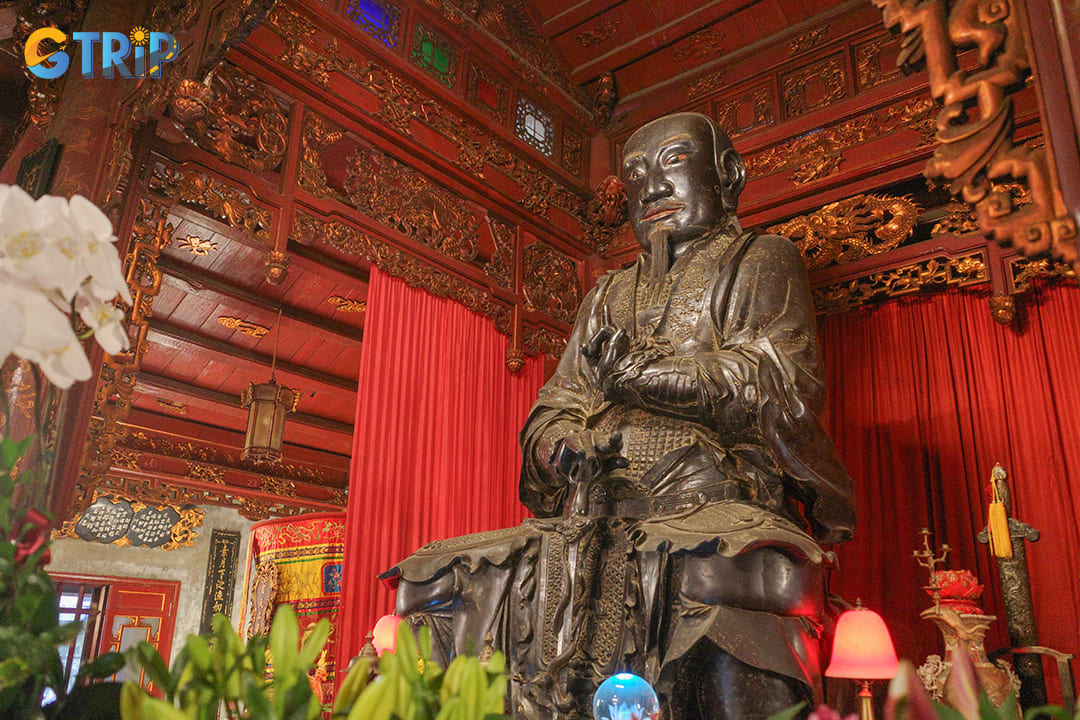
At the spiritual heart of Quan Thanh Temple stands Huyen Thien Tran Vu, one of the most revered deities in Vietnamese Taoism
Devotional practices
Devotees visit Quan Thanh Temple seeking various forms of divine assistance from Tran Vu:
| Type of request | Offering usually made | Typical practices |
|---|---|---|
| Protection | Incense and flowers | Praying and meditation |
| Business success | Fruit and money | Multiple visits on auspicious days |
| Health concerns | Special paper offerings | Extended prayer sessions |
| Family harmony | Complete altar sets | Family group worship |
| Academic success | Symbolic paper items | Student prayers before examinations |
Tourists observe local worshippers performing careful rituals, bowing respectfully before approaching the main altar. The relationship between devotees and Huyen Thien Tran Vu reflects a deep cultural tradition of seeking spiritual protection from forces beyond human control.
The architecture of Quan Thanh Temple
Quan Thanh Temple showcases a magnificent, harmonious blend of traditional Vietnamese and Chinese architectural elements dating back to the 17th century. The temple's design follows classic feng shui principles, with structures arranged in perfect balance across multiple connected courtyards. Its ornate rooflines feature upturned corners typical of East Asian sacred buildings, creating a majestic silhouette against Hanoi's skyline.
Tourists first encounter the impressive tam quan (three-entrance gate) adorned with intricate mythical carvings that serve as spiritual guardians. The central doorway, reserved traditionally for deities and royalty, features elaborate stone reliefs of carp transforming into dragons. Flanking entrances display meticulously carved tigers, phoenixes, and the distinctive "nghe" (guardian lions) that protect the sacred grounds from evil spirits.
Beyond the entrance lie spacious ceremonial courtyards paved with ancient stones, where worshippers gather during festivals and important occasions. The central courtyard serves as a transition between the secular world and the sacred inner sanctum. Layered prayer halls with traditional wooden pillars progress toward the main sanctuary, creating a sense of journey toward the divine presence.
The temple houses several remarkable treasures that showcase Vietnamese craftsmanship over the centuries:
- A bronze bell cast in 1677, featuring delicate inscriptions and Buddhist symbolism
- The impressive black bronze statue of Huyen Thien Tran Vu (God of the North), standing nearly 4 meters tall and weighing approximately 4 tons
- Intricately carved wooden altars adorned with gold leaf decorations
- Ceremonial bronze objects, including incense burners, candle holders, and ritual vessels
The monumental Tran Vu statue exemplifies 17th-century Vietnamese bronze craftsmanship with remarkable attention to detail. Created during the Le Dynasty, the statue portrays the god seated regally with flowing robes and a stern countenance. His right hand holds a sword representing divine justice, while his left forms a sacred mudra gesture believed to grant blessings.
Throughout its history, Quan Thanh Temple has undergone numerous restorations while maintaining its original architectural integrity. After each repair, temple authorities commissioned commemorative steles documenting the renovations. The most recent stele, created by Viceroy Hoang Cao Khai in 1894 during Emperor Thanh Thai's reign, provides valuable insights into preservation efforts during the French colonial period.
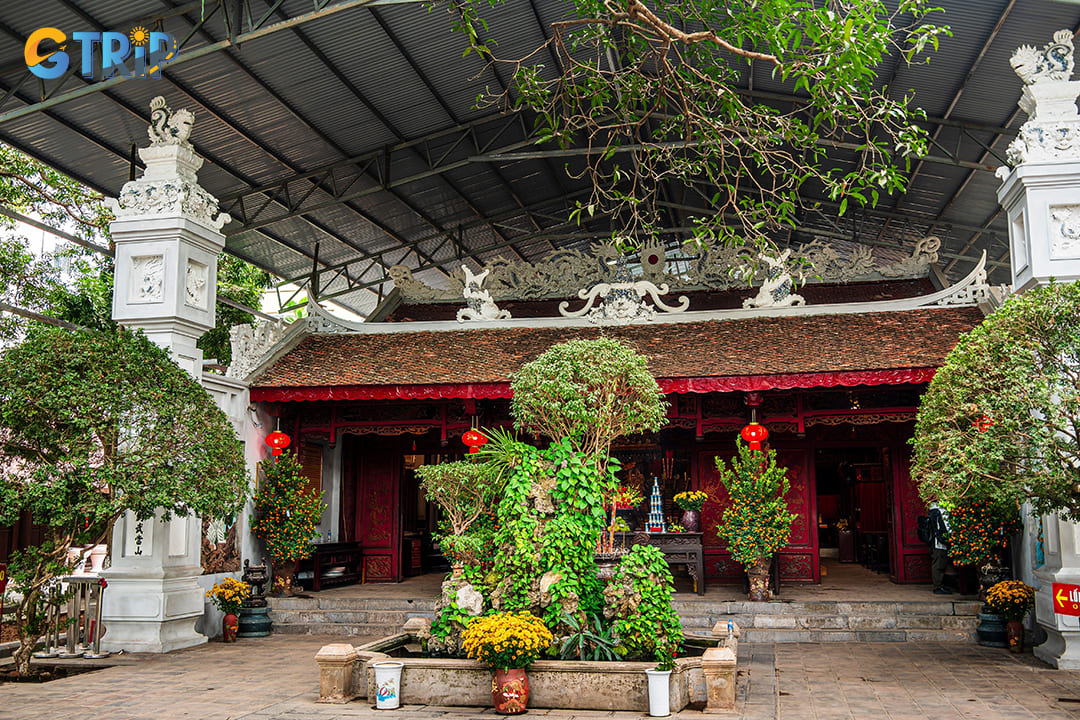
Quan Thanh Temple showcases a magnificent, harmonious blend of traditional Vietnamese and Chinese architectural elements
5 things to do at Quan Thanh Temple
Quan Thanh Temple offers tourists a rich tapestry of cultural, spiritual, and architectural experiences. This sacred site provides numerous engaging activities for travelers seeking authentic Vietnamese cultural immersion. Here are the five most rewarding experiences to enjoy during your visit.
1. Admire the majestic architecture
The temple's distinctive architectural style immediately captures tourists' attention with its harmonious blend of Vietnamese and Chinese influences. Red-lacquered columns adorned with intricate dragon motifs support the gracefully curved roof, creating a striking visual impact against Hanoi's urban landscape. The main entrance features three ornate doorways framed by stone carvings that depict ancient symbols and mythological creatures from Vietnamese folklore.
Inside, you can marvel at the meticulously crafted wooden beams and panels that have withstood centuries of Hanoi's humidity and seasonal changes. The inner courtyard provides a serene space where ancient banyan trees cast dappled shadows across stone pathways worn smooth by countless pilgrims. Elaborate stone carvings depicting celestial beings and symbolic animals adorn the walls and pillars, showcasing the exceptional craftsmanship of ancient Vietnamese artisans.
2. Explore the giant bronze statue of Huyen Thien Tran Vu
The centerpiece of Quan Thanh Temple is the magnificent black bronze statue of Huyen Thien Tran Vu, standing 3.96 meters tall and weighing an impressive 4 tons. This masterpiece, created in 1677 during the Le Dynasty, represents one of Vietnam's finest examples of bronze casting artistry. The deity is portrayed sitting majestically with one foot resting on a turtle and the other on a snake, symbolizing his power over both land and water.
You can observe the statue's remarkable details, including the deity's piercing eyes that seem to follow you around the room. Tran Vu holds a sword in his right hand while his left forms a mudra (symbolic hand gesture) representing protection and divine blessing. Local guides often point out the statue's perfectly balanced proportions and the incredible skill required to cast such a massive bronze work using 17th-century techniques. Many visitors touch the base of the statue for good fortune, creating a worn, polished area that contrasts with the rest of the dark patina.
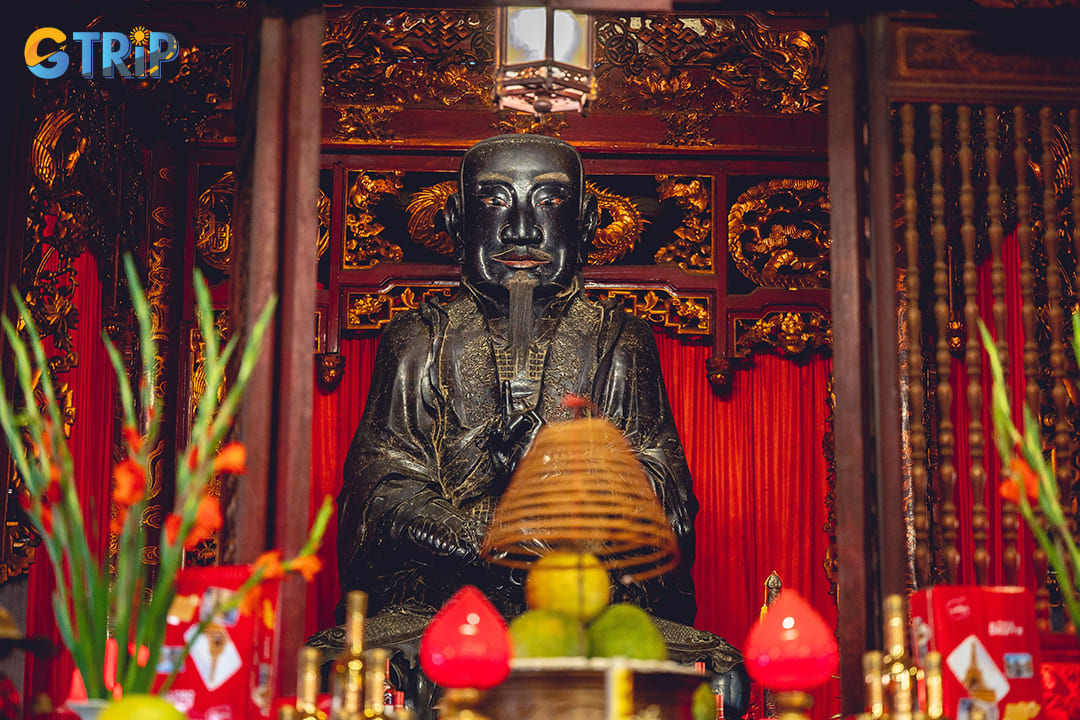
The centerpiece of Quan Thanh Temple is the magnificent black bronze statue of Huyen Thien Tran Vu
3. Capture stunning photos
Photographers will find that Quan Thanh Temple offers exceptional visual opportunities throughout its atmospheric grounds. The temple's distinct red and gold color scheme creates striking contrasts against the blue sky, especially during early morning or late afternoon golden hours. Sunlight filtering through incense smoke produces ethereal light rays that make for dramatic photographs of the temple's interior spaces.
The ornate roof decorations featuring dragons and phoenixes provide excellent detail shots that capture traditional Vietnamese architectural elements. When photographing inside, position yourself to capture the interplay of light and shadow across the bronze statue's impressive form. The temple's picturesque location beside West Lake offers opportunities to frame your shots with reflections in the water or with flowering trees in the foreground during spring months. Remember to be respectful when photographing worshippers or ongoing ceremonies, always asking permission before taking photos of individuals.
4. Make offerings and say prayers
Participating in the temple's spiritual practices offers you a genuine glimpse into Vietnamese folk religion and Taoist traditions. You can purchase incense sticks from vendors near the temple entrance to make offerings at the various altars. The ritual typically begins at the outer courtyard altar before proceeding to the main sanctuary housing the Tran Vu statue.
When making offerings, follow local customs by holding the incense with both hands at forehead level while silently making wishes or prayers. Many Vietnamese visitors bow three times after placing their incense in the large bronze urns positioned throughout the temple complex. Locals believe prayers for protection, health, and success in academic pursuits receive special attention from Tran Vu, the guardian deity of the north. Tourists can also observe or participate in fortune-telling rituals where wooden blocks are cast to receive guidance from the deity.
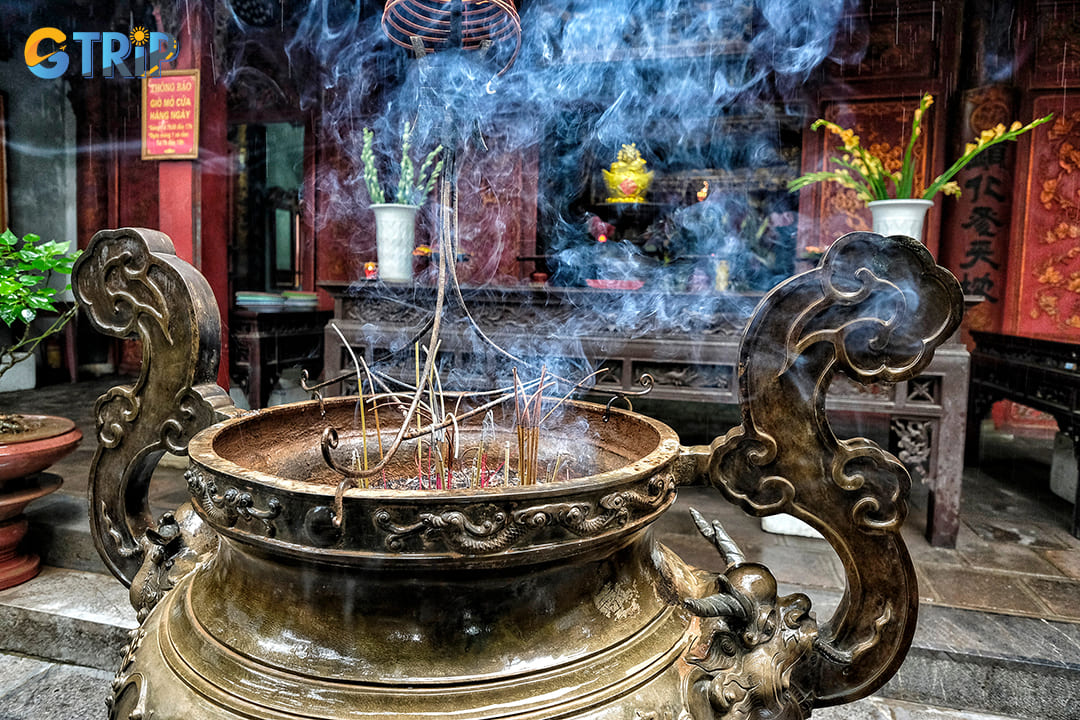
Participating in the temple's spiritual practices offers visitors a genuine glimpse into Vietnamese folk religion and Taoist traditions
5. Visit during Tet or special festivals
Experiencing Quan Thanh Temple during Vietnam's traditional festivals transforms an ordinary visit into an unforgettable cultural immersion. During Tet (Vietnamese Lunar New Year), the temple becomes a vibrant celebration center with colorful decorations, special offerings, and increased spiritual activities. Families arrive in traditional attire to pray for prosperity in the coming year, creating a lively, authentic atmosphere.
- Incense offering and worship ceremony: Conducted by male ceremonial officials and female incense bearers to honor Huyen Thien Tran Vu.
- Offering of ritual trays: Residents prepare 14 trays of offerings to show respect and unity.
- Palanquin procession and legend recital: The deity's palanquin is carried around the temple, accompanied by the reading of his sacred legend.
- Traditional cultural performances: Include folk music, poetry recitals, and artistic shows organized by the local community.
This celebration attracts both devoted followers and cultural enthusiasts looking to experience authentic Vietnamese traditions in their original setting. During festival periods, the temple remains open for extended hours, allowing tourists to witness evening ceremonies illuminated by hundreds of candles.
6. Experience night tour “The bell of Tran Vu” (Tieng chuong Tran Vu)
The “Tieng chuong Tran Vu” (The Bell of Tran Vu) night tour at Quan Thanh Temple is a newly launched 90-minute cultural experience. It is officially set to open to the public in August 2025. The tour begins at 7:30 PM and takes participants through a carefully choreographed journey that starts with three resonant bell tolls, an homage to the traditional Tran Vu festival. Guests witness sacred rituals like incense offerings and ceremonial chants. They then enjoy live tuong performances that bring to life the myths of Huyen Thien Tran Vu, his role in protecting Thang Long Citadel, and the artisan heritage of Truc Bach and Ngu Xa villages.
Beyond performances, the experience offers hands-on cultural engagement. Guests can sip traditional tea, wear historical costumes, try Vietnamese calligraphy, and explore ancient bronze artifacts housed in the temple. Highlights include the 3.6-ton bronze statue of Tran Vu and the temple’s iconic twin bronze lamps, all illuminated under atmospheric lighting. As the first night tour offered at one of Hanoi’s “tu tran” guardian temples, it blends sacred tradition with modern storytelling. Developed by Ba Dinh District in collaboration with heritage experts and tuong artists, “Tieng chuong Tran Vu” brings a fresh, interactive perspective to Hanoi’s night-time cultural landscape.

The “Tieng chuong Tran Vu” (The Bell of Tran Vu) night tour at Quan Thanh Temple is a newly launched 90-minute cultural experience
Nearby attractions from Quan Thanh Temple
Quan Thanh Temple's strategic location in Ba Dinh District places it at the heart of several iconic Hanoi attractions. You can easily combine their temple experience with explorations of surrounding landmarks, all within walking distance. The following destinations offer a perfect complement to your spiritual journey at Quan Thanh Temple, allowing you to maximize your time in this historic area of Hanoi.
Truc Bach Lake (350m)
Truc Bach Lake shimmers as a peaceful oasis in the bustling city, spanning 22 hectares with a shoreline extending 1.8 kilometers. The lake was originally part of the larger West Lake until the Ly Dynasty separated it with a dam in the 17th century. Locals and tourists alike stroll along its picturesque banks under the shade of ancient trees throughout the day.
The lake's surroundings feature charming cafes and restaurants where you can enjoy traditional Vietnamese coffee while gazing at the calm waters. Truc Bach Lake gained historical significance as the location where former US Senator John McCain landed after his plane was shot down during the Vietnam War. A small memorial marks this spot, adding a layer of contemporary history to the scenic beauty.
Food enthusiasts will delight in sampling the area's specialty, pho cuon (rice noodle rolls), at the numerous eateries along the eastern shore. The lake's proximity to Quan Thanh Temple makes it an ideal next stop after exploring the ancient religious site, offering a refreshing change of scenery just minutes away on foot.

Truc Bach Lake shimmers as a peaceful oasis in the bustling city, spanning 22 hectares with a shoreline extending 1.8 kilometers
West Lake Hanoi (350m)
West Lake stands as Hanoi's largest freshwater lake, encompassing an impressive 500 hectares with a shoreline stretching 17 kilometers. This massive body of water has been a focal point of Hanoi's cultural and spiritual life for over a thousand years. The lake offers a welcome retreat from urban congestion with its expansive views and cooling breezes.
Around its perimeter, you can find luxurious hotels, upscale restaurants, and trendy cafes that contrast with traditional temples and pagodas. The lake transforms throughout the day; morning brings tai chi practitioners and joggers, while sunset draws photographers and couples seeking romantic views. Boat rentals allow tourists to explore the lake from a different perspective, providing exceptional photo opportunities of the Hanoi skyline.
West Lake's shores host numerous flower gardens that bloom seasonally, adding splashes of color to the landscape. The 15-kilometer cycling route around the lake ranks as one of Hanoi's most scenic bike rides, allowing tourists to experience the area's changing scenery at a leisurely pace.

West Lake stands as Hanoi's largest freshwater lake, encompassing an impressive 500 hectares with a shoreline stretching 17 kilometers
Tran Quoc Pagoda (900m)
Tran Quoc Pagoda stands majestically on a small peninsula extending into West Lake, just 900 meters from Quan Thanh Temple. This Buddhist temple claims the title of Hanoi's oldest pagoda, dating back to the 6th century during the reign of Emperor Ly Nam De. Its distinctive 11-story red pagoda tower has become an iconic symbol of Hanoi's spiritual heritage.
The pagoda complex houses numerous precious artifacts, including ancient stone steles and intricate Buddha statues from various historical periods. Bodhi trees grow throughout the grounds, propagated from a cutting said to come from the original tree under which Buddha attained enlightenment. You can light incense, make offerings, and observe Buddhist ceremonies that continue age-old traditions.
The location offers breathtaking views across West Lake, especially beautiful during sunrise and sunset when golden light bathes the ancient structures. Photography enthusiasts particularly favor the spot where the pagoda's reflection shimmers on the lake's surface. Access is convenient through the main gate at 46 Thanh Nien Street, making it an essential stop when exploring the vicinity of Quan Thanh Temple.
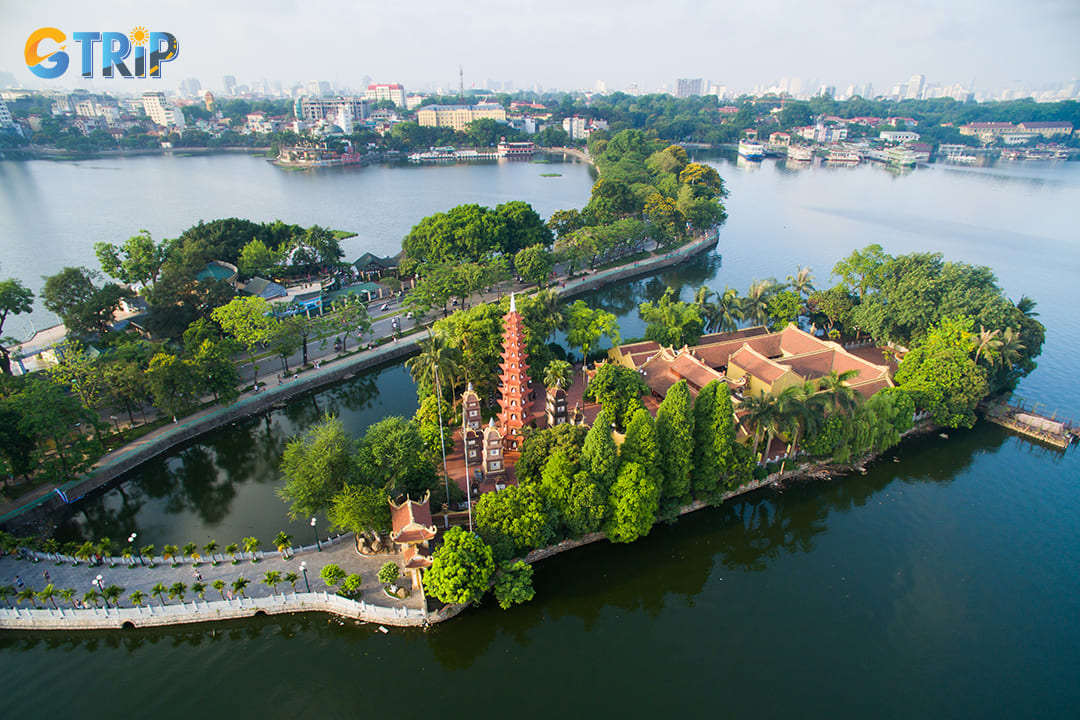
Tran Quoc Pagoda stands majestically on a small peninsula extending into West Lake
Complex of Ho Chi Minh President (500m)
Ho Chi Minh Presidential Complex stands just 500 meters from Quan Thanh Temple, serving as Vietnam's most significant historical monument. This sprawling area encompasses several important sites, including the marble Ho Chi Minh Mausoleum, where you can pay respects to the preserved body of Vietnam's revolutionary leader. The distinct yellow Presidential Palace, built in 1906 in French colonial style, contrasts with Ho Chi Minh's simple wooden Stilt House, where he chose to live.
| Site within the Complex | Features | Opening hours |
|---|---|---|
| Ho Chi Minh Mausoleum | The final resting place of Ho Chi Minh, a monumental marble structure | 7:30 - 10:30 AM, Closed Monday & Friday |
| Presidential Palace | French colonial architecture, official government functions | Exterior viewing only |
| Stilt House | Simple wooden home where Ho Chi Minh lived from 1958-1969 | 7:30 - 11:00 AM, 1:30 - 4:00 PM |
| One Pillar Pagoda | Unique temple designed to resemble a lotus flower | 8:00 AM - 5:00 PM daily |
| Ba Dinh Square | Location of Vietnam's Declaration of Independence in 1945 | Always open |
You should note the strict dress code requiring modest clothing covering shoulders and knees when entering the mausoleum. Photography restrictions apply in certain areas, particularly inside the mausoleum itself. The complex offers fascinating insights into Vietnam's struggle for independence and Ho Chi Minh's enduring legacy as the nation's beloved leader.
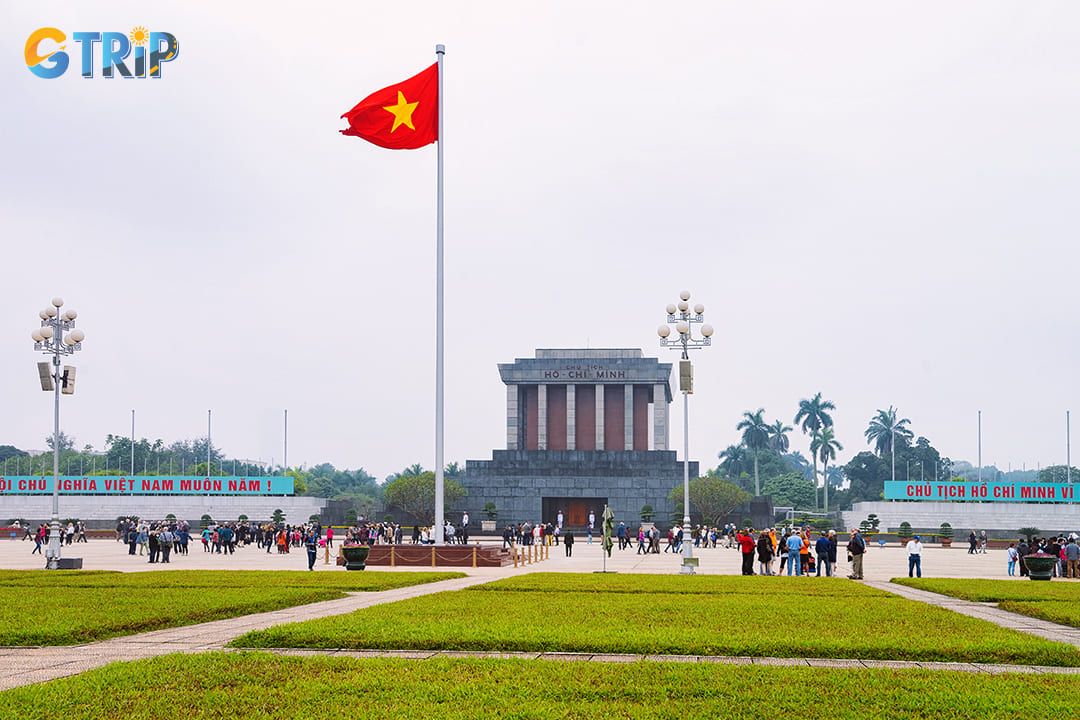
The Ho Chi Minh Presidential Complex serves as Vietnam's most significant historical monument
You can also see 3 other attractions considered part of the Four Guardians of Thang Long, each representing a cardinal direction, along with Quan Thanh Temple located to the North of the citadel.
Visiting Quan Thanh Temple offers more than just a glimpse into Hanoi's rich cultural tapestry. It’s a journey into the heart of Vietnam's spiritual and historical essence. By exploring this majestic temple, you've immersed yourself in centuries-old traditions and architectural beauty that resonate with the tranquility and depth of Vietnamese heritage. As you reflect on your visit, consider how these moments have enriched your understanding of Hanoi's cultural landscape. If you are interested in exploring this temple or any other attractions in Hanoi, you can consider booking Hanoi tours of GTrip - Vietnam Travel Agency. We offer curated tours that meet customers' needs and support with our best to help you fulfill your journey.

